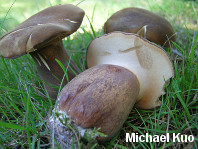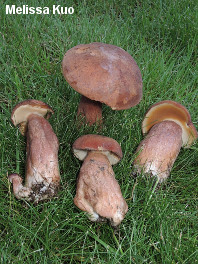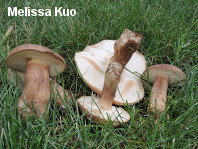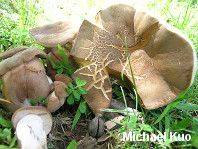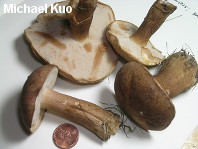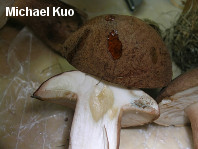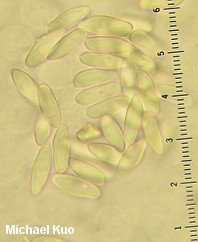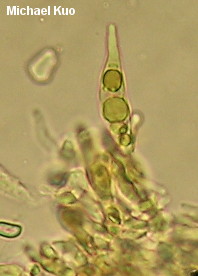| Major Groups > Boletes > Tylopilus > Tylopilus ferrugineus |

|
Tylopilus ferrugineus [ Basidiomycota > Boletales > Boletaceae > Tylopilus . . . ] by Michael Kuo Separating Tylopilus ferrugineus from Tylopilus badiceps is no easy task. Both species are associated with oaks in eastern North America, both have pigmented stems and brown-bruising pore surfaces, and both feature a mild (rather than bitter) taste. However, Tylopilus ferrugineus is brown to reddish brown (rather than maroon) when young, often features uncharacteristically firm flesh for a bolete, often appears stocky and hard when young, and has spores that measure 10–14 µm long (the spores of Tylopilus badiceps, in contrast, are 8–11 µm long). An additional means of separating the two species may be suggested by my collecting experience; I only find Tylopilus ferrugineus in grassy areas in urban locations or in parks, while my collections of Tylopilus badiceps have all been woodland. Tylopilus indecisus is also similar, but features a whitish-when-young stem and softer flesh. Description: Ecology: Mycorrhizal with oaks; growing alone, scattered, or gregariously; summer and fall; widely distributed east of the Rocky Mountains. The illustrated and described collections are from Illinois. Cap: 3–10 cm; convex when young, becoming broadly convex or nearly flat in age; dry; very finely felty when young, becoming bald; brown to reddish brown, fading to tan. Pore Surface: Creamy white, remaining so for quite a while but eventually becoming pinkish and eventually nearly brownish; bruising promptly brown; pores circular to angular, 2–3 per mm; tubes to 17 mm deep. Stem: 2–10 cm long; 1–4 cm thick; club-shaped when young, becoming more or less equal; brown like the cap except for a pale apical zone; bald; not reticulate, or merely finely so near the apex; basal mycelium white. Flesh: Notably firm when young and fresh; white; staining pinkish to brownish when sliced. Odor and Taste: Odor not distinctive, or sweet and thick; taste mild, not distinctive. Chemical Reactions: Ammonia negative to gray on cap surface and flesh. KOH dark red to black on cap surface; yellowish to orangish on flesh. Iron salts negative on cap surface; negative to bluish or slightly greenish on flesh. Spore Print: Brownish pink to pinkish brown. Microscopic Features: Spores 10–14 x 3–4.5 µm; subfusiform; smooth; yellowish in KOH. Hymenial cystidia up to 40–60 x 5–10 µm; fusiform to fusoid-ventricose; smooth; golden in KOH. Pileipellis a collapsing trichoderm; golden in KOH; terminal cells cylindric with rounded, subacute, or fusiform-cystidioid apices, 2.5–5 µm wide. REFERENCES: (Frost, 1874) Singer, 1947. (Saccardo, 1891; Snell & Dick, 1970; Both, 1993; Bessette, Roody & Bessette, 2000.) Herb. Kuo 09020103, 07020701, 07130803, 06201001, 07231003, 06211508, 06211509. This site contains no information about the edibility or toxicity of mushrooms. |
© MushroomExpert.Com |
|
Cite this page as: Kuo, M. (2016, May). Tylopilus ferrugineus. Retrieved from the MushroomExpert.Com Web site: http://www.mushroomexpert.com/tylopilus_ferrugineus.html |
